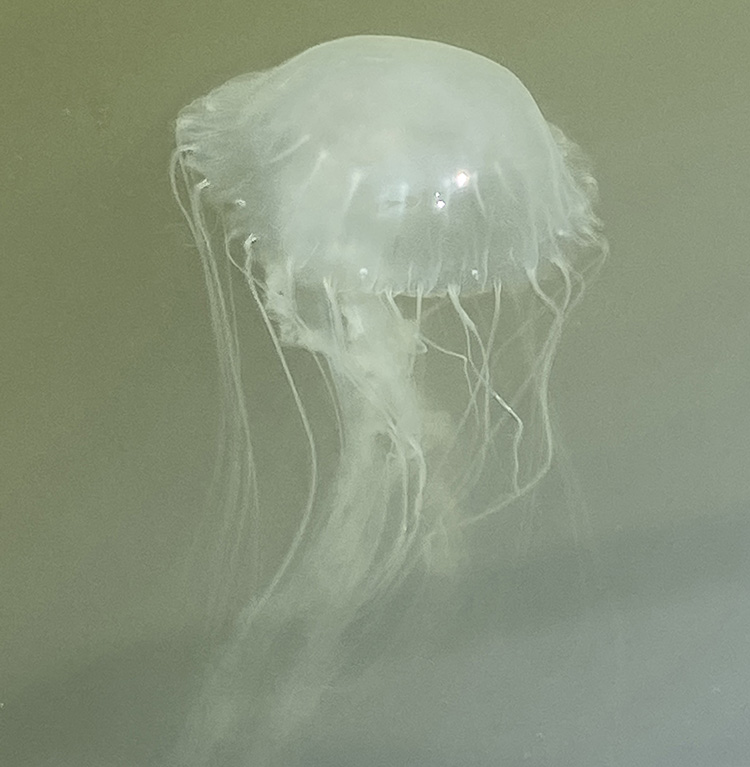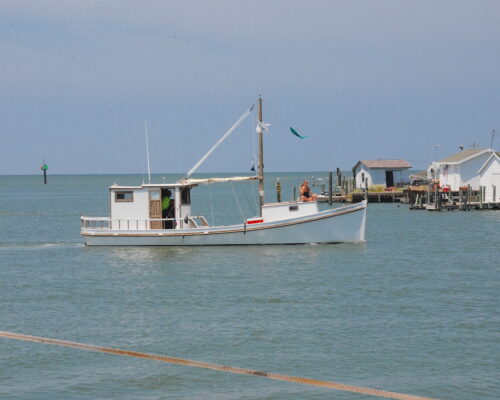The first time I paid attention to a jellyfish was years ago when my 4-year-old son stood waist-deep in the Chesapeake, screaming, as pink welts rose across his chest. He had tangled with a sea nettle (Chrysaora chesapeakei), the most common jellyfish in the Bay.
“Splash seawater on it and sprinkle this on his chest,” said our friend, pulling a shaker of meat tenderizer out of her beach bag with confidence. It was my introduction to the sketchy and remarkably robust underworld of Chesapeake folk remedies for jellyfish stings.
The sting of some jellyfish, notably the box jellyfish of Australia, can be fatal to humans. Our local sea nettle delivers a moderately painful sting that doctors say is not usually dangerous unless the recipient develops a severe allergic reaction or a small child is stung over a large part of their body (in which case call 911 immediately). The pain from most sea nettle stings usually peaks within five minutes and dissipates over the next few hours.
Dr. Erin Rafferty, a pediatrician affiliated with Children’s Hospital of the King’s Daughters in Norfolk, has written, “most [jellyfish stings] are not emergencies. If your child is stung, try to remain calm and reassure your child that they will be ok.”
I am convinced that the rapid onset of acute pain coupled with the knowledge that there is no need for professional medical attention spurred the plethora of folk remedies that may be as much placebo as panacea.
My friend Buck, an unofficial keeper of Eastern Shore folkways, says, “Mom would mix the tobacco from a cigarette with water into a paste and put that on a sting.” There is evidence that Native Americans applied tobacco leaves directly to the body to alleviate pain and that a tobacco poultice was used prior to 1860 to treat insect stings, so this may be the oldest known recipe for relief from Chesapeake jellyfish stings.
Many swear that papain, the enzyme found in many commercial meat tenderizers, neutralizes the venom of jellyfish stings. A 1972 article in the Journal of the American Medical Association claimed that a quarter teaspoon of meat tenderizer mixed with a teaspoon of water and rubbed on the skin at the site of the sting causes “virtually all pain to stop within seconds.” But newer research discredits this remedy’s purported effectiveness and WebMD.com discourages its use.
As my sons grew older, they developed their own solution when they were stung while swimming with friends: vigorously rubbing the sting with wet sand. I viewed this remedy as a harmless acknowledgment that the pain would be fleeting and it was not worth stopping their fun. But there may be some justification, as the health department in Branford, Connecticut, recommends rubbing sand over stings and flushing with salt water to dislodge the tiny stingers, called nematocysts.
Other folk cures call for dousing the sting in vinegar, alcohol or ammonia, coating it in shaving cream, scraping with a credit card, rubbing with a towel, or applying a baking soda and seawater poultice.
Finally, there is the most controversial folk remedy for jellyfish stings-human urine. This traditional remedy was made infamous by a 1997 episode of the sitcom Friends when the group learned that Chandler peed on Monica in an attempt to assuage the pain of a sting. I am pleased to report that ample medical evidence, including a 2016 scientific study titled “To Pee, or Not to Pee,” indicates that urine has no salutary effects on jellyfish stings and may cause stinging cells embedded in the skin to trigger, making the pain more intense.
The truth is that there is no firm consensus from the medical profession on the ideal treatment for sea nettle stings. The Seattle Children’s Hospital provides the following care advice for stings from jellyfish in the Chesapeake:
• Rinse the area with seawater to remove large tentacles.
• Scrape the area with a credit card or blunt knife to remove small stingers.
• Rinse the area with a mixture of seawater and baking soda for 15 minutes (for Chesapeake jellyfish do not use vinegar, which may trigger the stingers).
• As needed, give the patient pain medicine such as acetaminophen, rub with an ice cube, and apply hydrocortisone cream.
New prevention and treatment solutions are being developed, too. You can buy anti-jellyfish sting lotion that creates a slippery surface on the skin that reportedly makes it difficult for jellyfish tentacles to attach to the skin (safesea.store). Swimmers can create jellyfish-free zones with products like the Nettle Net boat pool, a portable, floating barrier between swimmers and sea nettles that is locally made in Millersville, Maryland (nojellyfish.com). A spray is also available that the manufacturers say provides rapid relief for stings of all classes of jellyfish (stingnomore.com).
One preventative recommendation that I simply cannot endorse: wearing pantyhose while swimming in the Bay. Yes, jellyfish stings are painful. But I hope we can all agree that it’s better to suffer an occasional sting than to trade the freedom and joy of splashing in the Bay for the confining, clingy embrace of a pair of clammy hosiery. If the sea nettles are so thick you are contemplating swimming in pantyhose, please exercise the only 100% foolproof way of avoiding stings—grab a beer, sit high and dry on your boat or dock and watch the jellyfish enjoying their lives pulsing around in the beautiful Chesapeake Bay.
Disclaimer: Any health information contained in this article is for educational purposes only. Readers assume full responsibility for how they choose to use it.
Create Jellyfish-Free Swimming Zones with Nettle Net Boat Pool
By Kiersten Hacker
From longtime family recipes to online remedies or scientific recommendations, many have their preferred method for treating pesky stings from sea nettle in the Chesapeake. But with Nettle Net Boat Pool, there is no need to prepare for a sting in the first place, swimmers can jump in the water worry free.
Nettle Net Boat Pool is available in an 8-foot, 12-foot or 20-foot diameter and comes with a foot pump and storage bag with a price range of about $600 to $1,600. This makes it easy to create a jellyfish-free swimming area right off a boat’s platform or a dock for those of all ages to take part in the fun of wading in the refreshing waters during the season.

Once the pool’s rim is inflated and the top-notch Halkey-Roberts valve closed, the weighted line at the bottom of the netting will form a pool about 8 feet deep. The first swimmer can adjust the rim to be round as the rest join in to enjoy the strong protection from the fine netting.
A long day in the sun can be tiresome, but cleanup is simple. After pulling the pool out of the water, the valve is quickly released and the pool can drain before bringing it home. The pool can be rinsed and dried in the sun for its next painless use.
No one wants to experience a jellyfish sting, so Nettle Net Boat Pool minimizes worries while maximizing boating fun season after season.
Robert “Gus” Gustafson lives on the Eastern Shore of Virginia by way of Chicago, Harvard University and a career on Capitol Hill. In his spare time, he coaches Broadwater track and field teams and cultivates heirloom vegetables from the Chesapeake region.
Kiersten Hacker is a rising senior from Long Island, New York studying journalism with a minor in public leadership at the University of Maryland. Her favorite things about the Chesapeake Bay are the rich history and culture, as well as the beautiful nature.




